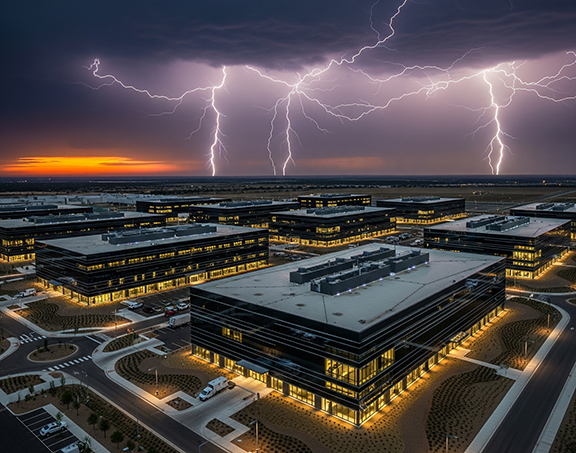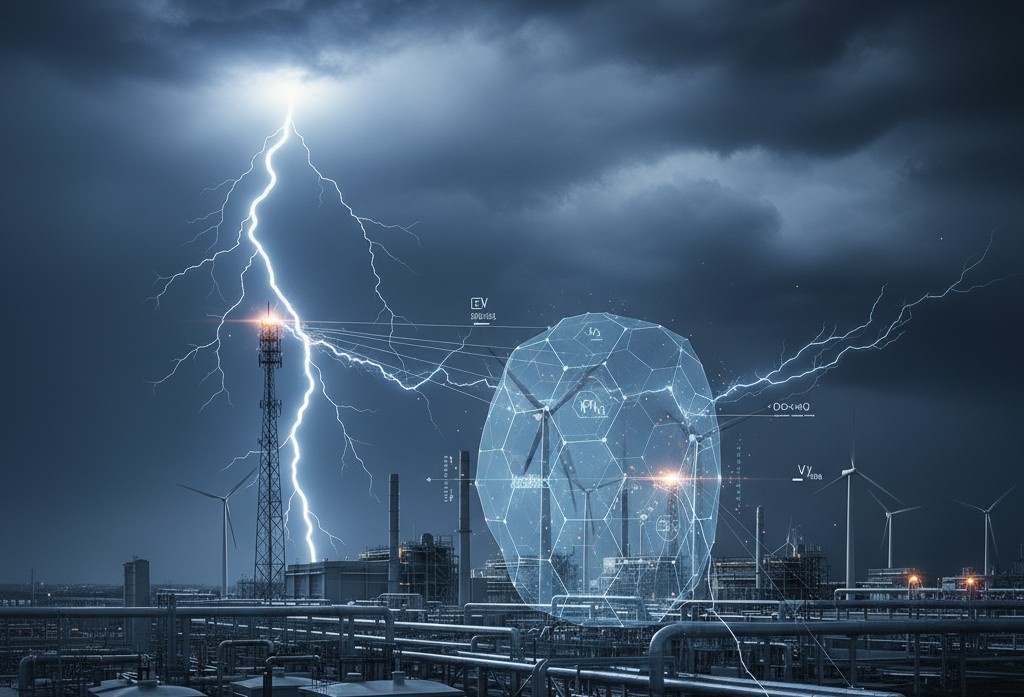Every year, lightning strikes the United States over 25 million times, causing billions of dollars in damage to businesses and industrial facilities. If your company operates mission critical systems, comprehensive lightning risk analysis isn’t optional—it’s essential for keeping your operations running and protecting your assets.
What is Lightning Risk Analysis and Why Your Business Needs It
Lightning risk analysis is a systematic process that identifies, measures, and prioritizes the lightning threats facing your facility. This scientific approach combines weather data, building characteristics, and your specific operational needs to create targeted protection strategies.
The consequences of a lightning strike go far beyond what most business owners realize. A single strike can shut down manufacturing for weeks, destroy critical data systems, or cause equipment failures that cost millions to repair. Without proper lightning risk assessment, your business faces:
- Unplanned downtime that costs thousands of dollars per hour
- Equipment replacement expenses that can reach into the millions
- Data loss that damages customer relationships and trust
- Safety incidents that put your employees at risk
- Insurance complications that could leave you without coverage when you need it most
Modern lightning risk assessment transforms these unknown threats into manageable business risks. By using data-driven analysis and strategic protection planning, you can protect what matters most to your operation.
The Science Behind Professional Lightning Risk Assessment
Professional lightning risk assessment starts with understanding your facility’s unique vulnerability to lightning strikes. Lightning isn’t random—it follows predictable patterns based on geography, building structure, and atmospheric conditions.
Geographic Risk Factors
Where your facility is located determines how much lightning exposure you face. Weather data shows that some regions experience far more thunderstorms than others, with varying intensity and seasonal patterns. Areas with higher keraunic levels (the number of thunderstorm days per year) need stronger protection strategies. Furthermore, a growing body of evidence suggests that climate change is increasing both the frequency and intensity of lightning strikes in many parts of the world, making robust protection even more critical.
Ground flash density measurements give you precise data about strike probability for your specific location. When combined with local terrain analysis, this information creates accurate risk profiles that help you make smart protection investments.
Structural Vulnerability Assessment

Your building’s characteristics play a major role in both lightning strike probability and potential damage. The key factors include:
- How tall your building is compared to surrounding structures
- What construction materials you use and how well they conduct electricity
- Architectural features like towers, antennas, or chimneys are more vulnerable to lightning strikes
- How sensitive your equipment is to electrical surges
- The condition and effectiveness of your current grounding system
Operational Impact Analysis
Lightning risk assessment must consider how strikes would affect your specific business operations. Your critical systems need different protection levels than non-essential equipment. Assessment protocols examine:
- What happens to your processes when they’re interrupted
- How vulnerable your data systems are to electrical damage
- What safety requirements you must meet to protect personnel
- Which regulatory compliance obligations you must maintain
- Your insurance coverage and liability considerations
Lightning Risk Management: Building Comprehensive Protection Strategies
Effective lightning risk management uses multiple layers of protection designed for your facility’s specific vulnerabilities. This systematic approach goes beyond simple lightning rods to create complete protection systems.

External protection intercepts direct lightning strikes before they reach your facility. Modern systems use air terminals, down conductors, and grounding networks designed according to international standards like IEC 62305 and NFPA 780.
Advanced external protection includes:
- Strategically placed air terminals optimized for your building’s geometry
- Low-resistance down conductors that provide safe paths for electrical discharge
- Comprehensive grounding networks that efficiently dissipate electrical energy
- Bonding systems that equalize electrical potential across your structures
Internal Protection Solutions
Internal protection safeguards your electronic systems from power surges and electromagnetic interference. Even lightning strikes that occur nearby can generate damaging voltage spikes that travel through power lines, data cables, and communication networks.
Key internal protection components include:
- Surge protection devices installed at service entrances and near sensitive equipment
- Power conditioning systems that maintain clean electrical supply
- Data line protection for communication and control networks
- Electromagnetic shielding around critical electronic systems
Integration with Business Continuity Planning
Lightning risk management extends beyond physical protection systems to include operational procedures and emergency response protocols. Successful programs integrate:
- Weather monitoring systems that provide advance storm warnings
- Clear operational procedures for high-risk weather conditions
- Emergency response plans specifically for lightning-related incidents
- Personnel training programs that cover essential safety protocols
- Insurance coordination that documents your protection measures
Advanced Lightning Risk Mitigation Through Technology
Modern lightning risk mitigation uses cutting-edge technology to provide better protection and operational intelligence. These advanced systems turn static protection into dynamic, responsive solutions.
AI-Integrated Risk Assessment

Artificial intelligence is revolutionizing lightning risk assessment accuracy by processing massive datasets that would be impossible for humans to analyze efficiently. AI-powered lightning risk assessment software analyzes:
- Historical weather patterns and lightning data
- Your facility’s specific characteristics that influence vulnerability
- Your equipment’s sensitivity profiles to determine protection requirements
- Economic factors that help optimize your protection investments
Industry-Specific Lightning Risk Considerations
Different industries face unique lightning challenges that require specialized assessment approaches. Understanding these sector-specific requirements ensures your protection strategy addresses the realities of your operation.
Manufacturing and Industrial Facilities
Manufacturing operations face complex lightning risks because of expensive equipment, continuous processes, and safety-critical systems. Lightning risk assessment for these facilities must consider:
- Process interruption costs that often exceed direct damage expenses
- Equipment sensitivity that varies across different manufacturing systems
- Safety system reliability that protects personnel and surrounding communities
- Supply chain impacts from extended downtime periods
Industrial facilities often operate around the clock, which complicates storm response procedures. Risk assessment must balance your operational requirements with safety considerations during high-risk weather conditions.
Data Centers and Technology Infrastructure

Data centers represent critical infrastructure that requires the highest protection levels. Even brief power interruptions can cascade into widespread service outages affecting thousands of customers.
Specialized considerations include:
- Protecting uninterruptible power systems from electromagnetic interference
- Maintaining cooling system continuity to prevent equipment overheating
- Preserving network connectivity to maintain communication links during storms
- Ensuring backup generator reliability for continued operations during extended outages
Healthcare and Life Safety Applications

Healthcare facilities cannot tolerate power interruptions that might affect life support systems or critical medical equipment. Lightning risk assessment for these environments requires:
- Redundant protection systems that provide multiple backup levels
- Emergency power reliability that maintains critical system operations
- Medical equipment sensitivity considerations that address electromagnetic interference
- Patient safety protocols during severe weather events
Telecommunications and Utilities

Telecommunications infrastructure spans vast geographic areas with varying lightning exposure levels. Risk assessment must address:
- Network-wide vulnerability mapping that identifies high-risk locations
- Service continuity requirements that maintain communication during storms
- Remote facility protection where immediate response may be impossible
- Interconnection protection that prevents damage from spreading between facilities
Implementing Effective Lightning Protection Programs
Successful lightning protection programs require systematic implementation that addresses technical, operational, and management considerations. This comprehensive process ensures your protection investments deliver maximum value.
Assessment and Planning Phase
Professional lightning risk assessment begins with comprehensive facility evaluation. This process includes:
Site characterization that documents geographic, meteorological, and structural factors affecting your lightning exposure. Professional assessment teams use specialized equipment to measure soil resistivity, electromagnetic field levels, and your existing protection system’s effectiveness.
Vulnerability analysis that identifies specific equipment and systems most susceptible to lightning damage. This detailed inventory considers replacement costs, operational criticality, and failure consequences for each major system component.
Risk quantification that calculates probability-weighted loss estimates for different protection scenarios. This economic analysis supports your investment decisions by demonstrating the protection system cost-effectiveness.
Protection strategy development that designs comprehensive solutions addressing your identified vulnerabilities. Professional engineers create detailed specifications ensuring compliance with applicable standards and regulations.
System Design and Installation
Protection system design requires coordination between multiple engineering disciplines. Electrical engineers design grounding networks and surge protection systems. Structural engineers evaluate any building modifications needed for external protection components.
Installation quality directly affects protection system performance. Professional installers follow manufacturer specifications and industry standards throughout the process. Quality control procedures verify proper system integration and performance.
Maintenance and Performance Monitoring
Lightning protection systems require regular maintenance to preserve their effectiveness over time. Inspection programs identify deteriorated components before they compromise system performance.
Testing protocols verify continued compliance with protection standards. These procedures include:
- Visual inspections that check for physical damage or corrosion
- Electrical testing that measures grounding system resistance and continuity
- Component verification that confirms surge protector functionality
- Documentation updates that maintain current system records
Skytree Scientific: Leading Innovation in Lightning Risk Analysis
Skytree Scientific develops advanced solutions that transform lightning risk analysis from reactive assessment into proactive protection planning.
LRA Plus™: Next-Generation Risk Assessment Technology
LRA Plus™ represents our commitment to advancing lightning risk assessment through artificial intelligence integration. This sophisticated platform processes complex meteorological data streams, facility characteristics, and operational parameters to generate comprehensive risk profiles.
The software employs advanced algorithms that consider:
- Geographic variables including elevation, terrain, and regional climate patterns
- Structural vulnerabilities based on your building characteristics and equipment inventory
- Operational requirements that reflect your business continuity needs and critical system identification
- Economic factors that optimize your protection investments for maximum cost-effectiveness
Professional Services and Support
Skytree Scientific provides comprehensive professional services supporting lightning risk analysis and protection system implementation. Our team includes engineers and protection specialists with extensive experience across the lightning protection industry.
Service offerings include:
- Comprehensive risk assessments following international standards and best practices
- Protection system design recommendations tailored to your specific facility requirements
- Training programs that educate your personnel about lightning risks and response procedures
- Consultancy on even the most challenging lightning protection challenges
Measuring Return on Investment for Lightning Protection
Lightning protection investments require careful economic justification that demonstrates clear value to your business operations. Comprehensive cost-benefit analysis considers both direct protection benefits and indirect operational advantages.
Direct Cost Avoidance
Protection systems directly prevent equipment damage and business interruption losses. Quantifying these benefits requires:
Equipment replacement cost analysis that identifies vulnerable systems and their replacement expenses. This inventory includes not only purchase prices but also installation, configuration, and operational testing costs.
Business interruption impact assessment that calculates revenue losses during extended outages. Manufacturing facilities may lose production capacity worth thousands per hour. Service businesses face customer satisfaction impacts that affect long-term relationships.
Data recovery and system restoration costs often exceed initial equipment damage. Comprehensive backup and recovery procedures reduce these expenses but cannot eliminate them entirely without adequate protection.
Indirect Benefits and Risk Reduction
Lightning protection provides indirect benefits that may exceed direct cost avoidance:
Insurance premium reductions reflect lower risk profiles for protected facilities. Many insurance providers offer significant discounts for facilities with comprehensive lightning protection systems.
Regulatory compliance advantages help facilities meet safety and operational requirements. Industries with strict safety regulations benefit from documented lightning protection programs.
Competitive advantages result from improved operational reliability. Customers value suppliers who maintain consistent service levels despite weather challenges.
Employee safety improvements reduce liability exposure and support positive workplace environments. Comprehensive protection demonstrates your organizational commitment to personnel welfare.
Future Trends in Lightning Risk Analysis
Lightning risk analysis continues evolving through technological advancement and improved scientific understanding. These developments promise more accurate assessments and effective protection strategies.
Climate Change Impacts
Climate change is affecting thunderstorm patterns and lightning frequency in many regions. Risk assessment methodologies must adapt to changing atmospheric conditions and updated meteorological data.
Research indicates:
- Shifting storm patterns that require updated risk maps and protection strategies
- Increased storm intensity that may affect traditional protection system adequacy
- Extended storm seasons that expand high-risk periods for many geographic areas
- New vulnerability patterns as weather systems change their typical characteristics
Advanced Sensor Technology
Next-generation lightning detection systems provide unprecedented accuracy and real-time capability. These technologies enable:
Improved strike location accuracy that supports targeted protection system deployment and damage assessment procedures.
Enhanced electromagnetic characterization that provides detailed information about lightning current magnitudes and waveforms affecting protection system design.
Network-based detection systems that cover vast geographic areas with coordinated sensor arrays providing comprehensive lightning activity monitoring.
Conclusion: Securing Your Future Through Professional Lightning Risk Analysis
Lightning risk analysis provides the foundation for comprehensive protection strategies that safeguard your business operations against nature’s most unpredictable electrical phenomena. Professional assessment methodologies transform unknown vulnerabilities into manageable risks through systematic evaluation and targeted protection measures.
Investing in sophisticated lightning risk assessment capabilities delivers measurable returns through reduced losses, improved operational reliability, and sustained competitive advantages. Organizations that embrace comprehensive risk analysis position themselves for continued success despite increasingly complex operating environments.
Modern AI-enhanced assessment tools like Skytree Scientific’s LRA Plus™ represent the next evolution in protection planning, providing unprecedented accuracy and intelligence in lightning risk management. These advanced capabilities enable organizations to optimize protection investments while maintaining the highest safety and operational standards.
The future belongs to organizations that proactively address lightning risks through professional assessment and comprehensive protection strategies. The question isn’t whether lightning will strike—it’s whether your organization will be ready when it does.






